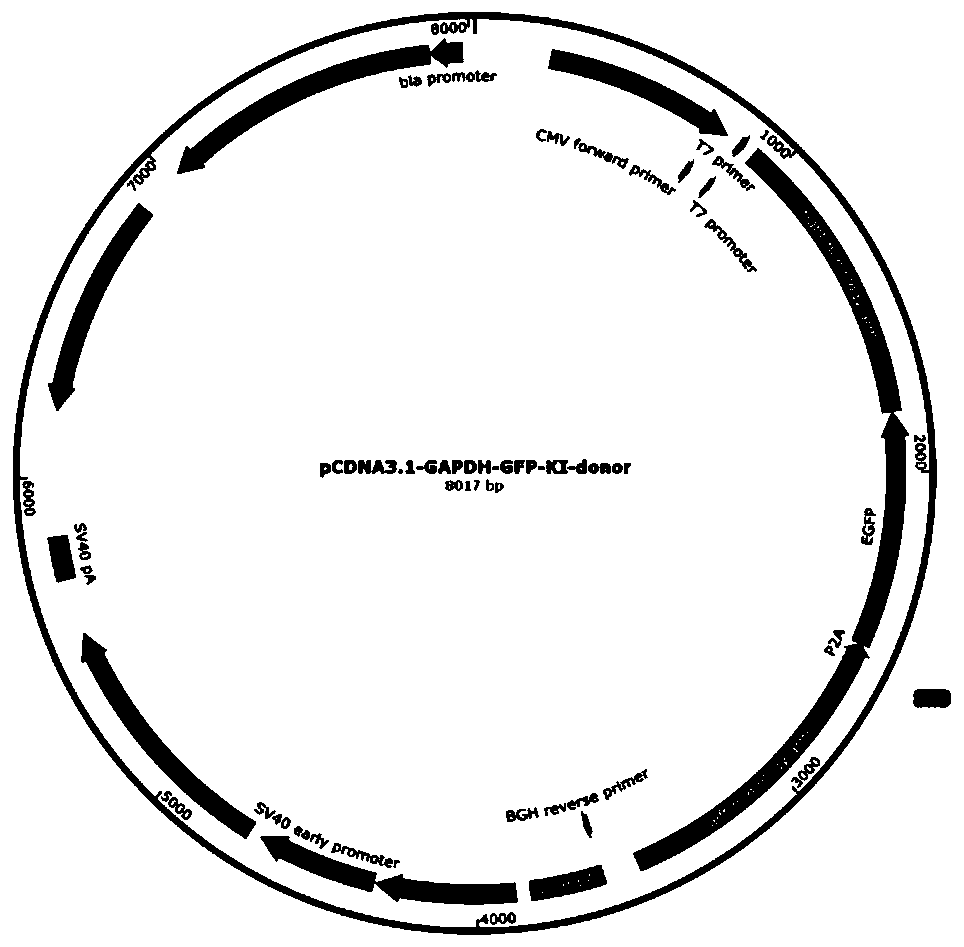Targeting vector construction method for site-directed integration of exogenous gene into GAPDH gene and its application
A technology of exogenous genes and targeting vectors, applied in the field of animal genetic engineering, can solve the problem of fewer exogenous gene sites, achieve the effect of simplifying the construction process and improving screening efficiency
- Summary
- Abstract
- Description
- Claims
- Application Information
AI Technical Summary
Problems solved by technology
Method used
Image
Examples
Embodiment 1
[0024] Example 1 Construction of GFP gene site-directed knock-in targeting vector
[0025] refer to figure 1 , a targeting vector for site-directed integration of exogenous genes into the downstream of the porcine GAPDH gene, with the 64129887-64130787 region of the GAPDH gene reference sequence (Gene ID: 396823) in NCBI as the left homology arm and the 64128983-64129883 region as the right homology arm In the origin arm, in order to prevent the GFP gene from being cleaved again by the CRISPR cutting vector after site-specific integration, the AAG codon at the position 64129890-64129892 on the left homology arm is synonymously mutated into AAA, and then the left homology arm sequence (SEQ ID NO .1), P2A sequence (shown in SEQ ID NO.2), GFP sequence (shown in SEQ ID NO.3) and right homology arm sequence (shown in SEQ ID NO.4) are sequentially connected to form The key sequence of homologous recombination site-directed insertion fragment.
[0026] refer to figure 2 , in a pr...
Embodiment 2
[0027] Example 2 CRISPR / cas9 cutting vector construction
[0028] A sgRNA sequence upstream of the stop codon of the porcine GAPDH gene was selected: CATGGTCCACATGGCCTCCA (shown in SEQ ID NO.5), named GAPDH-sgR1, and its reverse complementary sequence was: TGGAGGCCATGTGGACCATG (shown in SEQ ID NO.6). The oligonucleotide chains to be synthesized are shown in the table below, and the underlined part is the enzyme cutting site:
[0029]
[0030] Dilute the synthesized pair of oligonucleotide sequences to 10 μM, then take 5 μL each and mix evenly, and perform annealing treatment on a PCR machine, the program is: 95°C, 10 minutes; 65°C, 30 minutes. The annealed PCR product was ligated with the PX330 backbone digested with BbsI, a single clone colony was picked and sequenced, and the successfully constructed vector was named px330-GAPDH-sgR.
Embodiment 3
[0031] Example 3 Construction of GFP gene site-directed knock-in cell line
[0032] The above-mentioned GFP gene was knocked into the targeting vector pCDNA3.1-GAPDH-GFP-KI-donor and the CRISPR / cas9 cleavage vector were co-transfected into PK15 cells by lipofection method to construct a PK15 cell line stably transfecting the GFP gene, specifically The operation process is as follows:
[0033]The day before transfection, PK15 cells were seeded into 6-well culture dishes. Transfection was performed when the cells reached about 80% confluence the next day. According to the ratio of 1:1, the targeting vector pCDNA3.1-GAPDH-GFP-KI-donor and the CRISPR / cas9 cutting vector were co-transfected into PK15 cells, and the operation was performed according to the operation manual of lipo2000 (Invitrogen). After 48 hours of transfection, the fluorescence was observed, and the cell culture medium containing 800 μg / mL G418 was replaced, cultured in the medium containing G418 for three conse...
PUM
 Login to View More
Login to View More Abstract
Description
Claims
Application Information
 Login to View More
Login to View More - R&D
- Intellectual Property
- Life Sciences
- Materials
- Tech Scout
- Unparalleled Data Quality
- Higher Quality Content
- 60% Fewer Hallucinations
Browse by: Latest US Patents, China's latest patents, Technical Efficacy Thesaurus, Application Domain, Technology Topic, Popular Technical Reports.
© 2025 PatSnap. All rights reserved.Legal|Privacy policy|Modern Slavery Act Transparency Statement|Sitemap|About US| Contact US: help@patsnap.com



